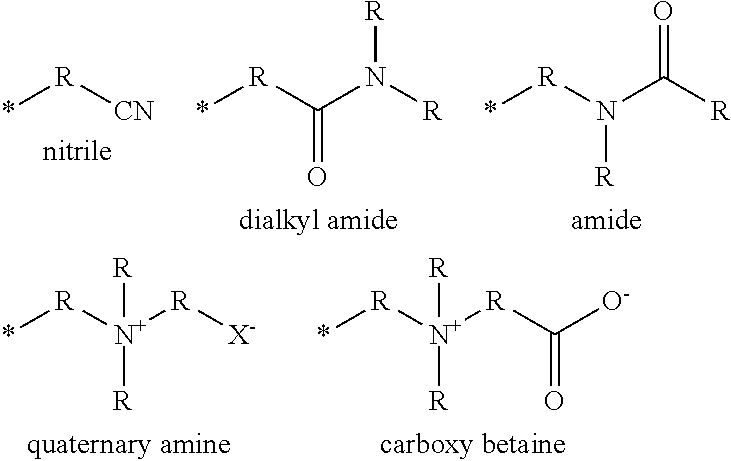Silicone hydrogel materials
- Summary
- Abstract
- Description
- Claims
- Application Information
AI Technical Summary
Benefits of technology
Problems solved by technology
Method used
Image
Examples
example 1
of Cyano Functional Disiloxy Methacrylate (Scheme1)
[0079]
[0080]To a flame-dried, round bottom flask is added methacyloyloxy propyl methyl dichloro silane (1 equivalent) 50 ml of diethyl ether under a N2 atmosphere. The flask is cooled to 0° C. under ice-water bath, and cyanoethyl chloro methyl silane (2.1 equivalents) is slowly added dropwise followed by the slow addition of water. The solution is stirred at 0° C. for one hour at which time the solution is brought to room temperature and stirred overnight. The following day, the solution is washed with a saturated brine solution. The organic layer is collected, and solvent evaporated to give the crude product, which was purified by thin film evaporation to remove the disiloxane by-product to give the high purity product.
example 2
of Nitrile Tri Siloxy Silane (Scheme 2)
[0081]
[0082]To a flame-dried, round bottom flask is added methacryloyloxy propyl trichloro silane (1.0 equivalent) 50 ml of diethyl ether under a N2 atmosphere. The flask is cooled to 0° C. under ice-water bath, and cyanoethyl chloro dimethyl silane (3.1 equivalent) is slowly added dropwise followed by the slow addition of water. The solution is stirred at 0° C. for one water at which time the solution is brought to room temperature and stirred overnight. The following day, the solution is washed with a saturated brine solution. The organic layer is collected, and solvent evaporated to give the crude product, which was purified by thin film evaporation to remove the disiloxane by-product to give the high purity product.
example 3
of Methyl Nitrile Tri Siloxy Methacrylate (Scheme 3)
[0083]
[0084]To a flame-dried, round bottom flask is added methacryloyloxy propyl methyl trichloro silane (1.0 equivalent) 50 ml of diethyl ether under a N2 atmosphere. The flask is cooled to 0° C. under ice-water bath, and cyanoethyl chloro dimethyl silane (1.0 equivalent) and trimethyl chloro silane (2.1 equivalent) is slowly added dropwise followed by the slow addition of water. The solution is stirred at 0° C. for one water at which time the solution is brought to room temperature and stirred overnight. The following day, the solution is washed with a saturated brine solution. The organic layer is collected, and solvent evaporated to give the crude product, which was purified by thin film evaporation to remove the disiloxane by-product to give the desired high purity product.
PUM
| Property | Measurement | Unit |
|---|---|---|
| Elasticity | aaaaa | aaaaa |
| Hydrophilicity | aaaaa | aaaaa |
| Oxygen permeability | aaaaa | aaaaa |
Abstract
Description
Claims
Application Information
 Login to View More
Login to View More - R&D
- Intellectual Property
- Life Sciences
- Materials
- Tech Scout
- Unparalleled Data Quality
- Higher Quality Content
- 60% Fewer Hallucinations
Browse by: Latest US Patents, China's latest patents, Technical Efficacy Thesaurus, Application Domain, Technology Topic, Popular Technical Reports.
© 2025 PatSnap. All rights reserved.Legal|Privacy policy|Modern Slavery Act Transparency Statement|Sitemap|About US| Contact US: help@patsnap.com



